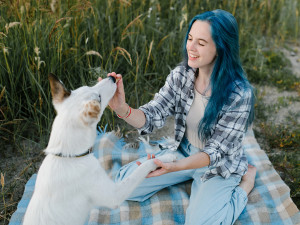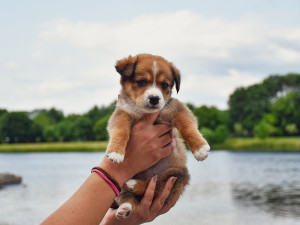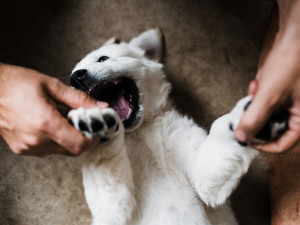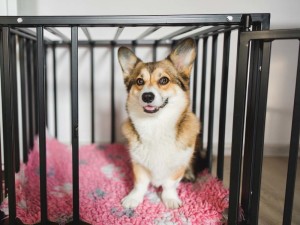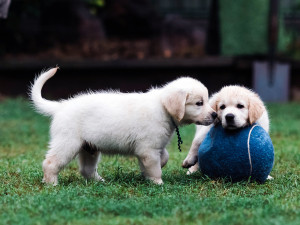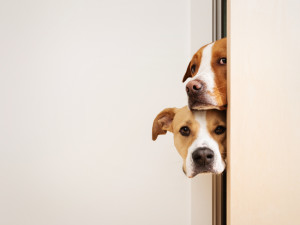The Go-To Training Schedule For Your Puppy
Your puppy training schedule, from eight weeks to six months. Let’s do this
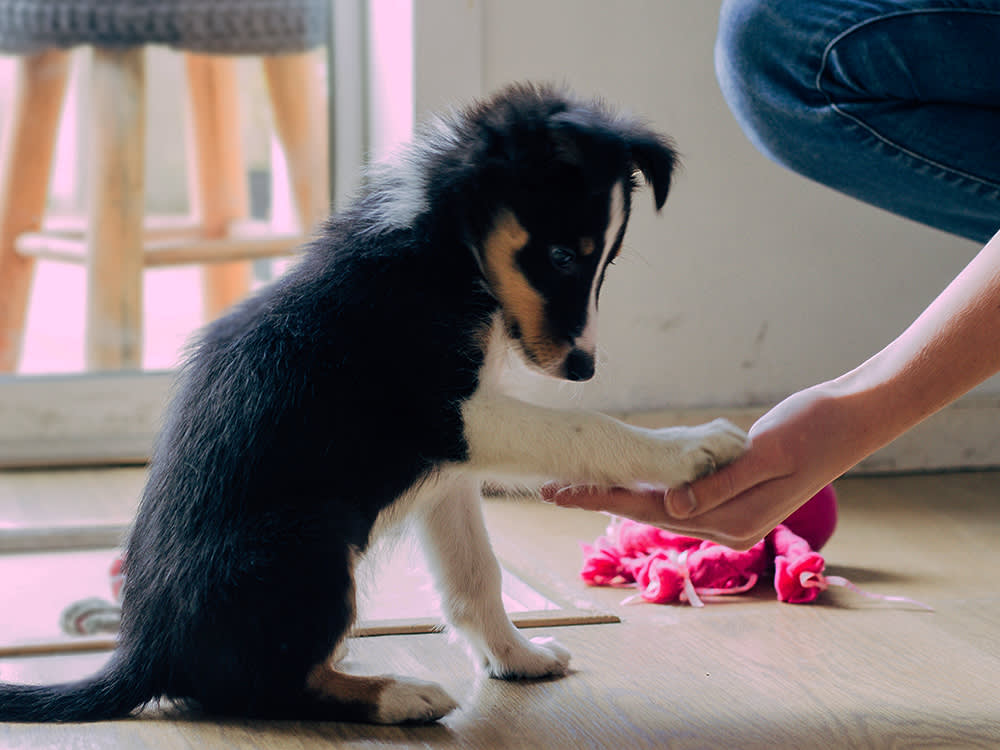
Share Article
So you’ve taken the plunge and got an impossibly cute puppy. Now, when should you start training that puppy? Hope you’ve been doing your vocal warm-ups because you’re going to be saying ‘aww’ and ‘no!’ a lot. Of course, all things will also soon be chew-worthy and bathroom breaks will seemingly be needed every five seconds. But don’t fret – if you’re running on a less-than-ideal amount of sleep courtesy of this new fluffy explorer learning about their new world, help is on the way. Here’s your puppy training cheat sheet to pull off your first six months together like a couple of pros.
When is the best time to start training a puppy?
Unofficial training begins as soon as you bring your puppy home. Your number one priority is to make sure they feel safe, bond with them and create some structure. Follow our timeline below to start training your puppy between eight to 12 weeks.
What training methods should I use for my puppy?
One of the most popular training methods for puppies is using positive reinforcement: the general thinking is that dogs will repeat good behaviour when they’re rewarded for it. Bad behaviour isn’t rewarded or even acknowledged. When you need to correct your puppy, you remove a reward like a toy or a treat. There is no reprimanding.
Along the same lines, using your puppy’s food or treats to train them is one of the best tools. By working with food, you will easily be able to get their attention and create a positive association with you giving them direction.
Puppy training schedule by age
Below is the ideal training schedule for the first six months of your pup’s life.
8–12 weeks
Bonding
This early time is for lots of love, positive experiences, exposure and learning about their home and family. It’s your puppy’s time to know they are home and safe.
Potty training
Puppies under 10 weeks old typically can’t hold their bladder for more than 30 minutes or so; that number will increase a bit each week. This means you either need to plan to take your pup outside consistently or, as a fallback, have a safe area available at all times (puppy pads or grass pads). Puppies need to go out:
when they wake up
after they eat
after they drink
after they play
any time they look confused
every 30 minutes
Basically, when in doubt, take them out. Every time your puppy goes to the loo outside, give them a high-value treat (something your pup loves) right after they finish doing their business, so they know to continue heading out whenever nature calls. Avoid punishing your puppy for accidents. It’s frustrating, but they’re still learning and can’t control themselves. Clean it up, throw it in the wash and get back to rewarding your puppy for all the right things they’re doing.
Socialisation
Learning how to socialise your puppy is arguably the most important piece of any successful puppyhood (with proper vaccinations and go-ahead from your vet, of course). This is the process of teaching your puppy all about the world through positive, gradual experiences.
The world can be scary for a puppy and it’s your job to help them learn it doesn’t have to be. Signing up for a puppy socialisation class or working with a trainer when they’re young can help your pup establish a positive comfort level from the start. The first 16 weeks are critical for your puppy’s development, so definitely don’t wait on this one.
Name recognition
Say your puppy’s name and give them a treat. After enough repetitions – which shouldn’t be a problem since volunteers will be lining up for this tough assignment – your pup will start to respond at the sound of their name and know something good will follow. And ta-da, one of many sweet milestones to be accomplished.
12–16 weeks
Keep up socialisation
Why? That limited window isn’t closed yet, but we’re getting close. Keep focusing on new experiences. Don’t wait (you know you’d rather take your puppy everywhere as your plus-one anyway).
Home-alone training
Puppies – and dogs in general – are not predisposed to being alone. It takes time and positive experiences to learn that being home alone is safe and to be honest, kind of great. Start by creating good experiences in safe places, such as a puppy pen, crate or made-safe-for-your-puppy room. Use lots of treats and toys your pup loves and a favourite bed.
Leave for only seconds or minutes at a time. Gradually increase time if your puppy is comfortable – they may vocalise a little, but excessive whining, crying and barking equals distress. Don’t let them just ‘cry it out’. If your puppy isn’t progressing being home alone within a week or so, contact a positive reinforcement trainer for help sooner rather than later.
Bite inhibition
Puppies bite. A lot. It’s normal. Part of your job is to help them learn they can play with other dogs and toys with their mouth, but your skin is sensitive. Over the first several months, we ‘shape’ our dogs to use their mouths more softly. They get to bite a little bit but don’t be afraid to use those toys to redirect them when it gets too rough.
Basic cues and behaviours
This can be a good time to start teaching some very basic cues to help open communication with your puppy. If needed, don’t hesitate to work with a positive reinforcement trainer for help. My top three behaviours to teach puppies:
touch/hand target
offered attention (looking at you)
‘drop it’ or ‘leave it’ (start with trading for treats)
Lead training
You will be working on walking on a lead for months or longer. But this is a good age to introduce a lead, let your puppy drag it around, and start to reward your pup for walking with you. Harnesses are also the best fit for a young puppy learning about lead walking (actually best for all dogs during walks and healthier for their necks). Be generous with treats to teach them what you want and be patient.
16–24 weeks
Don’t rush to teach too many things too fast. Learn about your puppy and what their specific needs are. There is so much time to teach new behaviours. Focus on the foundations of just a few basic skills now and ensure your puppy is well-socialised, comfortable in the world, sniffing all the sniffs and having positive experiences on walks. They’ll be taking in new sights, sounds and experiences with ease. Not to mention, connecting with you. Just like humans, your new puppy will be learning forever. Slow down and enjoy the walk.
Six months and beyond
By six months, your puppy should know their basic commands and have a pretty good handle on potty training, crate training and socialising with other dogs. It’s important to continue to make progress every month after that. Keep meeting new people and dogs and exposing your puppy to new experiences and sounds. Your puppy should also be able to increase time in between bathroom breaks. You should also continue to:
Reinforce commands
Consistency is key for your puppy. Continue to reinforce the commands your puppy has learned, increasing distance between the two of you each time, especially the recall command. You can also improve their response by practising in different distracting environments.
Keep structure in place
Your puppy still needs all the rules, so don’t be surprised if they start chewing things or having accidents when you loosen their lead, so to speak. Keep a schedule for your puppy and continue to train them so you don’t lose progress.
What can I achieve by starting training early?
Starting obedience training early is all about ensuring that your puppy has the manners you want them to as they grow up and get bigger. It’s a lot easier to pick up a 7kg puppy who isn’t listening versus a 30kg grown dog! By training early, you’re setting yourself and your puppy up for more peaceful cohabitation for the rest of both of your lives. Here’s a list of other reasons why:
Your puppy will be easier to train between 8-20 weeks when their brains are like sponges and ready to soak up all of your commands. They also have more energy at an early age.
In the beginning, you are your puppy’s whole world, so they will be more likely to pay attention to you and less likely to be distracted while you’re training them.
Training your puppy is a great bonding experience for both of you early on. They learn that you are invested in them and want to spend time with them.
How long does it take to train a puppy?
Looking for a puppy-training timeline? Potty training generally takes four to six months. And obedience training can take anywhere from one to three years, depending on your dog.
Frequently asked questions
Can I start training before eight weeks of age?
Generally, true training before eight weeks old isn’t advisable; it’s more important to bond with your puppy during that time and make them feel safe at home.
What are the essential commands to teach a puppy?
According to the RSPCA, the most important commandsopens in new tab to teach your puppy are sit, wait and coming back when called.
How often should I train my puppy?
You should formally train your puppy once or twice a week, but keep up with the obedience practice every day.
What if my puppy shows resistance to training?
It’s common for some puppies to be difficult to control and train, but that behaviour should decrease after 6-9 months. If resistance persists, seek out a professional trainer.
Are there any specific socialisation tips to keep in mind?
It’s important to expose your puppy to different people and dogs in various environments. Puppy socialisation classes are also a good option.
References
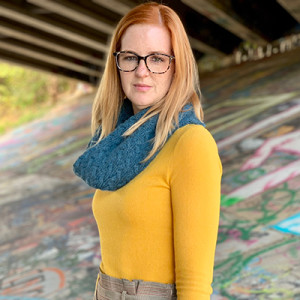
Melissa Dallier, CPDT-KA
Melissa Dallier is a Certified Professional Dog Trainer (CPDT-KA) and Dogly Training Advocate. Her specialty is helping pet parents feel more connected to your dog through positive, evidence based training. Melissa lives in Colorado with her two dogs Rodger and Moxie.
Related articles
![Two Golden Retriever puppies playing with a large blue tennis ball outside in the grass]()
What to Expect At Puppy Socialisation Classes
A dog behaviourist schools us on why puppy classes are more about socialising than getting straight As
![Two hands holding a very young tan and white puppy up in front of a lake landscape]()
How to Socialise a Puppy
Everything you need to know to get your new addition off to a good start
![Three dogs on leashes meeting and sniffing each other on a walk on the summer grass with owners]()
How Do I Get My Shy Dog To Socialise?
Dog trainer Robert Haussmann’s tips for getting a shy pup to go from wallflower to social butterfly
![Smiling Welsh Corgi Pembroke dog sitting inside an open crate]()
How to Crate Train a Puppy
Effective techniques to crate train your dog with ease
![Woman walking her dog in a park]()
Dog Walking 101: How Often You Should Walk Your Dog
Your dog may need more exercise than you think, according to three pet experts
![Two fearful adolescent dogs peeking through a slightly open door]()
Does Your Dog Have Juvenile Onset Shyness?
Turns out, the teenage years aren’t just tough for humans – they can be rough on dogs, too

